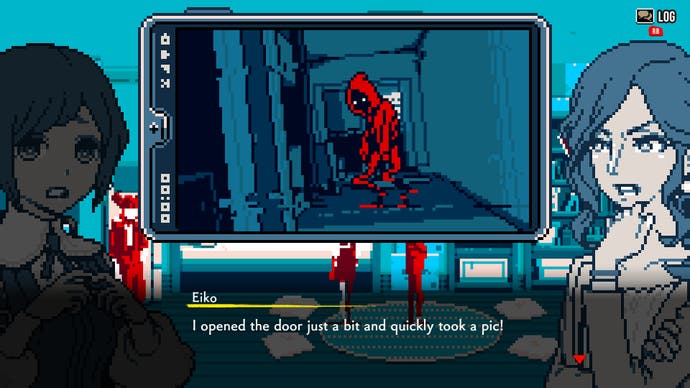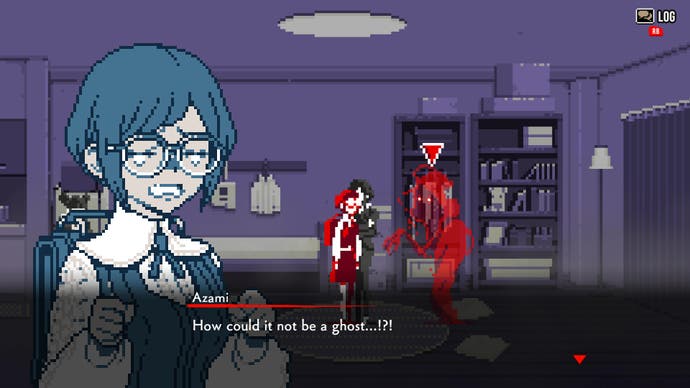Listen up Paranormasight fans, this is your next great spooky Japanese detective game
The demo for Urban Myth Dissolution Center is open for business.
Talk about a rough first day at work. You sit down to start explaining all the strange ghosts you've been seeing lately, only for your new boss to suddenly pipe up and say that, sorry, that chair is actually cursed and anyone who sits on it is doomed to die. My bad! It certainly makes for a chilling start to Hakababunko's brilliant Steam Next Fest demo for their upcoming, spook-filled mystery game Urban Myth Dissolution Center, and fans of last year's excellent Paranormasight would do well to keep this one firmly in their sights when it launches in full next February.
For starters, it has the same keen focus on discerning fact from fiction, and its striking pixel art is just as nuanced and characterful as Paranormasight's moody cell-shaded portraits. Sure, it probably won't be quite as devious or twisty-turny in the long run, at least not based on its hour-long demo, or from my experience playing the developer's previous detective game, Makoto Wakaido's Case Files Trilogy, last Christmas (which also has a free demo at the moment, too, if you fancy a more straightforward crime thriller). It's clear that both of Hakababunko's games share a lot of the same basic DNA on this front. But still, for those after a knotty and haunting little scare ahead of Halloween this week, this is one Next Fest demo you absolutely must try for yourself.
Of course, with your own life at stake right from the get-go, it definitely lends the tutorial section of the game a welcome bit of perilous zip. For the freshly afflicted Azami to avoid her unfortunate fate, she'll need to get to the root cause of the curse by carefully studying points of interest in the room around her, gathering clues based on what she observes, and then using her deductive skills to propose some possible answers. The former plays out like a classic point and click adventure, and as in Makoto Wakaido, the number of clues you've got left to find is always flagged up in the corner so you always know how close you are to reaching your goal.


Some clues aren't immediately visible in this plane of reality, however. Fortunately for Azami, she possesses the rare power of clairvoyance, and thanks to a handy set of glasses that focus her nascent abilities, she can swiftly swap between each state to identify all kinds of supernatural nasties that are naked to the human eye. In the case of the cursed chair, there's a ghost who helps direct her to a particular set of files that will help her investigation, for example, but later on in the demo's first big case, these apparitions become traces of past events that allow her to work out how her friend was attacked by a mystery spirit.
These glasses also allow her to pick out important clues in the game's 'social media' sections, too, where Azami must search the web to track down the origin of the particular rumour she's been called to investigate so she can ground herself in the case's specifics before she arrives on the scene. While these portions do feel a little woollier than the rest of your investigation due to the sheer number of comments and posts you have to sift through to find the most pertinent clues, I was pleased to see that Azami and her driver/supervisor pal Jasmine had a bespoke dialogue response for each and every one of them. It might not be the right answer I'm clicking on, but at least I'm still learning something about their characters along the way.

Certain clues need to be teased out further before cases can move forward, though, and with a squeeze of the shoulder button, Azami can put her thinking cap on and hypothesise what might have happened. These sections take a leaf out of The Case of the Golden Idol's notebook, tasking players with filling in the blanks to create a sentence from a set of premade words and phrases. It's a bit nit-picky on grammar and sentence structure, admittedly - you won't get penalised if you get it wrong or anything, but on more than one occasion I had all the right answers, just in the wrong order. It does, at least, lock in what you get right if you need another attempt, but it could perhaps stand to flag up those correct, but misplaced word fragments a bit more clearly - a bit like how Golden Idol tells you when you're very nearly there but not quite.
Still, semantics aside, I like how even these big breakthroughs still only act as small pieces of the wider puzzle. As you might expect, Azami survives her encounter with the cursed chair (there wouldn't be the rest of the game without her), but as she delves deeper into her first real case, these revelation moments mostly just throw up more questions over the course of the investigation, leading to new avenues of enquiry, and new dialogue opportunities with the witnesses and victims. Urban Myth Dissolution Center plays its cards quite close to its chest in this respect, and with the demo ending on quite a big cliffhanger, I'm absolutely dying to find out what happens in the final game. It's got its claws in good and deep, this one, and I can't wait to play more next year.


